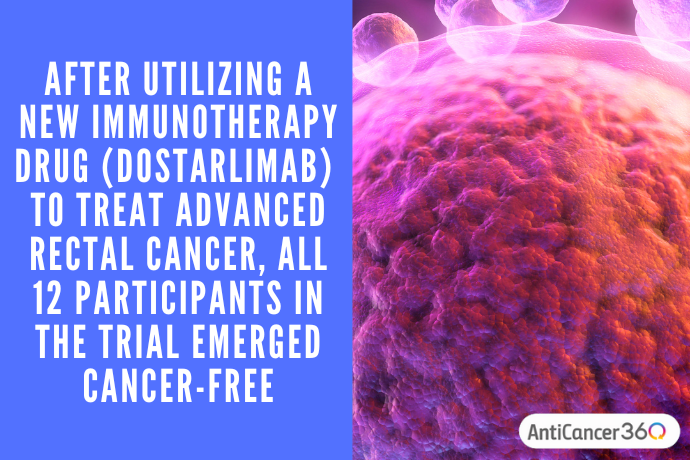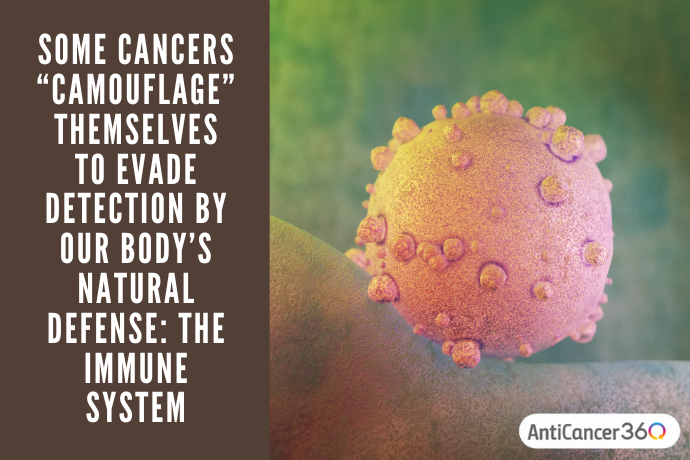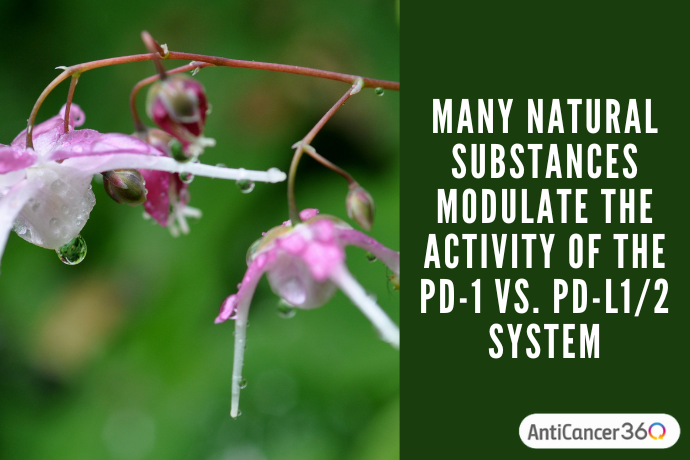A team of researchers from the Memorial Sloan Kettering Cancer Center (MSKCC) recently published extraordinarily successful results from a small clinical trial. After utilizing a new immunotherapy drug to treat advanced rectal cancer, all 12 participants in the trial emerged cancer-free. After six months, not a trace could be found in any of them. The study was published in the New England Journal of Medicine on June 23 [1].
The breakthrough drug in this trial was dostarlimab. Today’s blog will dive into dostarlimab’s anticancer mechanism and which cancer types may benefit from it. We’ll also explore some potential natural alternatives and/or complements to dostarlimab. Read on to learn more.
What Is Dostarlimab?
Dostarlimab received accelerated approval from the United States Food and Drug Administration (FDA) in April 2021. Full FDA approval of dostarlimab may be contingent upon the results of further clinical trials [2].

Below is a summary of basic facts about dostarlimab [3]:
- Type of therapy: Immunotherapy
- Brand name: Jemperli
- Pharmaceutical manufacturer: GlaxoSmithKline (GSK)
- Drug class: PD-1 (programmed death receptor-1) blocking antibody
- Route of administration: intravenous (IV) infusion
- Typical dosage: 500 milligrams (mg) intravenously every 3 weeks for four cycles, followed by 1,000 mg every 6 weeks
Next, we’ll look at how dostarlimab works in the body.
How Does Dostarlimab Work? Mechanism Of Action Explained
Dostarlimab is not a chemotherapy drug. It belongs to a broad category of biologic drugs called immunotherapy.
Dostarlimab works by binding to the PD-1 receptor of activated T cells. (T cells are a type of immune system cell.) PD-1 stands for programmed death receptor-1. It’s a protein on T cells that helps control the body’s immune response.
When PD-1 binds to ligand proteins called PD-L1 and PD-L2, it “puts the brakes” on T cells, stopping them from killing abnormal cells like cancer cells. But these brakes are lifted when dostarlimab blocks PD-1 from binding to PD-L1 and PD-L2. This frees T cells to hone in on certain unusual cells—including cancer cells—and destroy them.

Some types of tumors have a higher amount of PD-L1 and PD-L2 than usual. So, these ligands make a strategic bullseye for treating cancers with an “upregulation” of PD-L1 and PD-L2. In studies, blocking PD-1 activity was shown to decrease tumor growth.
Specifically, dostarlimab is FDA-approved (indicated) to treat recurrent, advanced, or inoperable solid tumors or endometrial cancers with a genetic mutation known as mismatch repair deficiency (more on this below). This drug is used in people whose cancer hasn’t responded to previous treatments.
Another way to summarize how dostarlimab works in simple terms: Some cancers “camouflage” themselves to evade detection by our body’s natural defense: the immune system. This makes certain cancers extremely difficult to treat. Dostarlimab is designed to remove this camouflage, exposing cancer to an attack from your immune system. So, administering dostarlimab every so often offers the opportunity to beat back the cancer, while leaving healthy cells largely unaffected [4].
About Mismatch Repair Deficiency
Here is a quick cell biology lesson to help understand the types of cancers that may benefit from dostarlimab.
DNA is self-replicating material that carries our genes. Before a cell divides to make more cells, it must first replicate or copy its DNA. Your DNA contains genes that carry the instructions for how to copy itself. If errors are made during the copying process, your DNA has built-in tools to fix the mistakes.
Mismatch repair deficiency describes cells that have changes or mutations in certain genes that are involved in correcting these DNA-replicating mistakes. Cells that have such mutations may become cancerous. Mismatch repair deficiency is most common in colorectal cancer. It may also be found in cancers of the endometrium (lining of the uterus), stomach, intestines, breast, bladder, thyroid, and prostate [5].

Further, cells with deficient mismatch repair produce mutated or abnormal proteins. Bearing or secreting proteins that the immune system hasn’t seen before is extra provocative. So, dostarlimab is intended to make the immune system even more vigilant against such abnormalities [6].
How To Get Dostarlimab
Dostarlimab can only be prescribed by a licensed medical provider. It is given as an intravenous infusion at a hospital, medical facility, or cancer center.
Based on the current FDA approval of dostarlimab, healthcare providers may prescribe this drug to treat the following advanced, recurrent, or inoperable types of cancers in eligible adults [7]:
- Adults with endometrial cancer that have mismatch repair deficiency (as confirmed by a diagnostic test) who were already treated with platinum chemotherapy (such as cisplatin or carboplatin) but it stopped working.
- Adults with solid tumors with mismatch repair deficiency, as determined (as confirmed by a diagnostic test) who have no satisfactory treatment options.
Talk to your oncologist if you think you qualify for this medication. If you do not meet the criteria described above, you may be able to receive dostarlimab through a clinical trial.
Dostarlimab Clinical Trials
Numerous clinical trials are ongoing to learn more about dostarlimab’s role in treating other specific cancer types, such as [8]:
- Breast cancer
- Cervical cancer
- Pancreatic cancer
- Lung cancer
- Skin cancer
- Liver cancer

Keep in mind that learning the results of ongoing trials may take a long time. At this phase, clinical trials typically last at least 1 to 4 years. If you’re interested in enrolling in a clinical trial using dostarlimab, you can learn more here at cancer.gov. You can also talk to your oncologist to find out if you might be eligible.
Dostarlimab Takeaway
Dostarlimab therapy has proved to be so impressive by specifically targeting the weaknesses of certain cancers without subjecting patients to the often harsh side effects of conventional chemotherapy.
The pivotal study, however, was not without limitations. The main drawback of the study was its small size (12 participants) and limited follow-up time. Further clinical trials are needed to learn about dostarlimab in a larger patient population, in other cancer types, and with extended follow-up.
Natural Alternatives Or Additions To Dostarlimab?
In the first part of today’s blog post, we talked about what you may have seen in news headlines: a small clinical trial showed an immunotherapy drug, dostarlimab, to be extraordinarily effective, with all twelve of its participants becoming cancer-free.
Now we’re going to touch on some herbs and supplements that have been shown to have mechanisms that are similar to that seen with dostarlimab. Note that many of the studies of anticancer herbs have been preclinical, meaning that they were tested on cells or animals in labs. But, these studies can still provide valuable information, including safety and potential efficacy.

Many natural substances modulate the activity of the PD-1 vs. PD-L1/2 system (i.e. how dostarlimab works). Some are commonplace, and some are more exotic. The most important ones are those that can possibly synergize and potentiate dostarlimab treatment [9]. We have a separate blog article all about resveratrol, mentioned below, in which you can read more about how this supplement may help fight cancer.
Icaritin
Icaritin is an herb from Traditional Chinese Medicine. This herb, Epimedium genus, has been shown to decrease PD-L1 production and strengthen PD-1 antibody blocking action in hepatocellular carcinoma (liver cancer) [10]. Other anticancer benefits of this plant have also been demonstrated [11].
Resveratrol
Resveratrol is a naturally occurring polyphenol. It is naturally found in red wine, red grape skins, mulberries, peanuts, and blueberries (as trans-resveratrol). Other sources include eucalyptus and spruce [12].
This popular herb has been shown to affect PD-L1 levels in ovarian cancer cells and form a powerful synergy with anti-PD-1 antibody treatment, causing significant regression [13].
Lycopene
Lycopene is a carotenoid found primarily in tomatoes. Other sources include guava, pink grapefruit, red oranges, apricots, rose hip, and watermelon [14].
In a mouse model of lung cancer, lycopene was found to reduce PD-L1 levels on the cancer cells. It also synergized with an anti-PD-1 antibody treatment to increase the treatment’s effectiveness [15].
Diosgenin
Diosgenin is a phytosteroid sapogenin sourced from wild yam species, such as the Kokoro. Diosgenin has been found to affect intestinal flora, boosting anti-PD-1 antibody therapy. Its influence on gut flora was shown to enhance T-cell-mediated tumor response [16].
Are You A Good Candidate For Our Program?
It can be overwhelming to decide on the best approach for fighting cancer. Many new treatments are becoming available. And there is often limited data on safely integrating herbs and natural supplements with conventional treatments.
If you’re looking for professional help and guidance on approaching your cancer treatment, please watch our free online webinar to learn more about our approach. Then at the end, you’ll be able to schedule a free call with someone from our team so that we can discuss your case in more detail.
Dr. Patricia Weiser is one of AntiCancer360’s consultant pharmacists, science advisors, and medical writers. Her expertise helps us create safe herbal and supplement combinations and avoid potential drug interactions.
Patricia is a graduate of the University of Pittsburgh and a licensed pharmacist. She has clinical experience in both community and hospital pharmacy. She is passionate about integrative and preventative care and strives to empower her patients to take an active role in their health.







